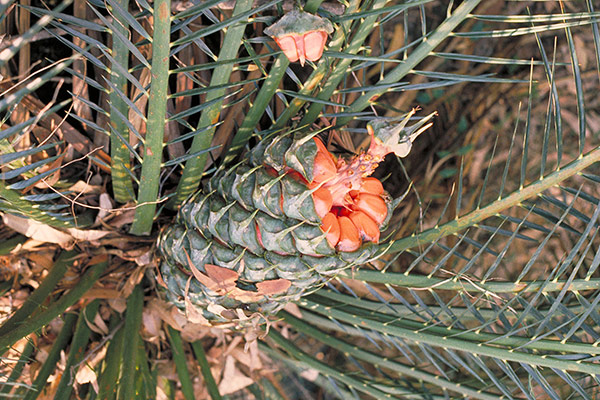
Australian Cycads
Jim Oliff
Cycads are plants of great antiquity, being the oldest living representatives of the Gymnosperms - the first seed-bearing plants. They are the descendants of the Bennettitales (cycad-ferns) which flourished in the Mesozoic age and probably dominated the vegetation of the world some 200 million years ago.
Though the cycads bear a physical resemblance to palms (and some, to ferns), botanically they are related to the conifers, since cycads bear their seeds in cones.
Cycads form an order of woody-stemmed plants, some with a stout colomnar trunk (called a caudex) a metre or so tall, and other with the caudex wholly underground. Their trunks consist of a core of fleshy conducting tissues with a tough, thick outer layer made up of rows of persistent leaf-bases terminating in a cluster of long leaves (or fronds) bearing many leaflets.
They grow as either male or female plants, the males bearing narrow elongated cones which produce pollen: the females produce much larger seed cones which, when mature, break open allowing the seeds to fall to the ground. The ripe seeds bearing a fleshy, brightly-coloured (orange to red) edible covering, are gathered by foraging marsupials, large birds and even fruit bats, who, after eating the covering, discard the hard seeds and thus distribute them over a wide area.
Australian Cycads are classified into three families, totalling some thirty species, almost all of them being endemic. (see footnote - ed)
- Family Cycadaceae - genus Cycas (15 species)
- Family Stangeriaceae - genus Bowenia (3 species)
- Family Zamiaceae - genus Lepidozamia (4 species); genus Macrozamia (25 species)
Most species are extremely slow-growing, producing only a few leaves each year. Large specimens are of great age and may be some of the oldest living plants on earth.
 |
|
 |
| Lepidozamia peroffskyana |
Occurrence: In Australia, cycads are distributed in the tropical and sub-tropical zones of the east coast and in the south-west of Western Australia in areas of medium-to-high rainfall, though one species occurs in the arid climate of Central Australia. There are none in Victoria and South Australia though there are fich fossil beds of ancient cycads in Victoria. In dry climates they grow mainly as scattered individuals but in moist areas occur in large colonies. Their habitats are generally open, from tall open forests to grass-lands and stony hillsides of shallow and rocky soils. On the Central Coast of New South Wales, 'Burrawangs' (Macrozamia communis) can be seen in large numbers in the forests of the National Parks extending from the coast to the western areas.
Reproduction: Pollination occurs in the warm months when the segments of the male cones open to allow the discharge of large quantities of pollen, which lies like brown dust on the cones, the fronds and the adjacent vegetation. Wind carries the pollen to the female cones but insects no doubt assist in the haphazard distribution process. The unfertilised seeds in the female cone, secrete a drop of moisture allowing the pollen to adhere and be drawn into the seed via small openings in the blunt end (micropyle) of the seed. Fertilisation occurs after the sperms of the pollen reach the egg-cell, a journey taking several months. Subsequent swelling of the female cone and discharge of the seed occurs relatively quicker.
 |
Female seed cone of Macrozamia communis,
releasing its large, orange seeds |
Horticulture: Cycads make excellent subjects for the garden or for growing in containers, though patience is the "name of the game" for their propagation and raising.
In the garden they will grow in virtually any position, including shade, but do best with at least some access to sunlight. Soil type is not critical provided it is well-drained, though they don't prosper on calcarious soils. Light applications of slow-release fertilisers are helpful. Pests are few, but caterpillars may damage young fronds and the older plants may be attacked by scale.
Propagation: The seeds are large and extremely hard. They should be sown at a shallow depth in a sandy, well-drained mix with the top part of the seed slightly above the soil surface. Seed trays or pots should be placed in a warm, sheltered location and kept just moist. Germination takes from one to two years. When the seed shoots, it puts down a fat taproot and then raises the first leaf. At this stage they can be potted-up. They transplant readily as their root system, apart from the thick taproot, is sparse.
The number of families and species listed in the original article have been updated to reflect current taxonomy.
From 'Native Plants for New South Wales', newsletter of the Australian Plants Society (NSW), September/October 1987.
Australian Plants online - 2009
Australian Native Plants Society (Australia)
|